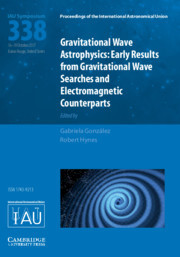Description
Gravitational Wave Astrophysics (IAU S338)
Early Results from Gravitational Wave Searches and Electromagnetic Counterparts
Proceedings of the International Astronomical Union Symposia and Colloquia Series
Coordinators: González Gabriela, Hynes Robert
S338 explores how space-time and electromagnetic messengers can be correlated, to help us understand many astrophysical phenomena.
Language: English
Subject for Gravitational Wave Astrophysics (IAU S338):
Publication date: 04-2019
118 p. · 17.9x25.5 cm · Hardback
118 p. · 17.9x25.5 cm · Hardback
Description
/li>Contents
/li>
Gravitational waves were predicted 100 years ago by Einstein as part of his general theory of relativity. This volume contains the exciting results presented at IAU Symposium 338, following the announcement of the first results of the observation of the collision of neutron stars by the LIGO and Virgo Advanced detectors, and follow-up observations by many ground-based and space telescopes. These observations provided an incredible context for the talks, posters and discussions at the meeting, fostering new interactions and collaborations between physicists and astronomers in an exciting new era of multimessenger astrophysics. For the first time, space-time messengers (gravitational waves) and electromagnetic ones (visible, infrared and ultraviolet light, x-rays, gamma-rays, radio waves) can be correlated, to increase our understanding of binary systems of compact objects, rotating or exploding stars and other astrophysical phenomena. A new window has opened through which we can view the cosmos.
1. Revealing short GRB jet structure and dynamics with gravitational wave electromagnetic counterparts Gavin Lamb; 2. Gravitational wave optical counterpart searching based on GRAWITA and DLT40 project during LIGO O2 run Sheng Yang; 3. On the host galaxy properties of stellar binary black hole mergers Youjun Lu; 4. Reanalysis of LIGO black-hole coalescences with alternative prior assumptions Davide Gerosa; 5. High accuracy measurement of gravitational wave back-reaction in the OJ287 black hole binary Mauri Valtonen; 6. Background rejection using convolutional neural networks Adam Zadrożny; 7. Merging massive black holes: the right place and the right time Astrid Lamberts; 8. Supermassive black hole binary candidates from the Pan-STARRS1 medium deep survey Tingting Liu; 9. GW170817: swift UV detection of a blue kilonova, and improving the search in O3 Aaron Tohuvavohu; 10. DESGW optical follow-up of BBH LIGO-Virgo events with DECam Robert Butler; 11. Cosmology with gravitational waves in DES and LSST Ken Herner; 12. Observations of GW170817 by DESGW and the DECam GW-EM collaboration James Annis; 13. Observations of the first electromagnetic counterpart to a gravitational wave source by the TOROS collaboration Lucas Macri; 14. AGILE observations of GW events Francesco Verrecchia; 15. High power in advanced LIGO Terra Hardwick; 16. Strong-lensing of gravitational waves by galaxy clusters Graham Smith; 17. How Einstein's theory of relativity gives us E = mc2 and the atomic bomb Richard Henry.
© 2024 LAVOISIER S.A.S.
These books may interest you

Probes of Multimessenger AstrophysicsCharged cosmic rays, neutrinos, γ-rays and gravitational waves 105.49 €

Rotating Relativistic Stars 132.31 €


